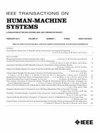SonoMyoNet: A Convolutional Neural Network for Predicting Isometric Force From Highly Sparse Ultrasound Images
IF 4.4
3区 计算机科学
Q2 COMPUTER SCIENCE, ARTIFICIAL INTELLIGENCE
引用次数: 0
Abstract
Ultrasound imaging or sonomyography has been found to be a robust modality for measuring muscle activity due to its ability to image deep-seated muscles directly while providing superior spatiotemporal specificity compared with surface electromyography-based techniques. Quantifying the morphological changes during muscle activity involves computationally expensive approaches for tracking muscle anatomical structures or extracting features from brightness-mode (B-mode) images and amplitude-mode signals. This article uses an offline regression convolutional neural network called SonoMyoNet to estimate continuous isometric force from sparse ultrasound scanlines. SonoMyoNet learns features from a few equispaced scanlines selected from B-mode images and utilizes the learned features to estimate continuous isometric force accurately. The performance of SonoMyoNet was evaluated by varying the number of scanlines to simulate the placement of multiple single-element ultrasound transducers in a wearable system. Results showed that SonoMyoNet could accurately predict isometric force with just four scanlines and is immune to speckle noise and shifts in the scanline location. Thus, the proposed network reduces the computational load involved in feature tracking algorithms and estimates muscle force from the global features of sparse ultrasound images.SonoMyoNet:从高度稀疏的超声波图像预测等长力的卷积神经网络
与基于表面肌电图的技术相比,超声成像或超声肌电图能够直接对深层肌肉进行成像,同时具有更高的时空特异性,因此被认为是测量肌肉活动的可靠模式。要量化肌肉活动过程中的形态变化,需要采用计算昂贵的方法来跟踪肌肉解剖结构,或从亮度模式(B-mode)图像和振幅模式信号中提取特征。本文使用一种名为 SonoMyoNet 的离线回归卷积神经网络来估计稀疏超声扫描线中的连续等长力。SonoMyoNet 从 B 型图像中选取的几条等间距扫描线中学习特征,并利用所学特征准确估计连续等长力。通过改变扫描线的数量来模拟在可穿戴系统中放置多个单元素超声传感器的情况,对 SonoMyoNet 的性能进行了评估。结果表明,SonoMyoNet 只需四条扫描线就能准确预测等长力,并且不受斑点噪声和扫描线位置偏移的影响。因此,所提出的网络可减少特征跟踪算法的计算负荷,并根据稀疏超声图像的全局特征估算肌力。
本文章由计算机程序翻译,如有差异,请以英文原文为准。
求助全文
约1分钟内获得全文
求助全文
来源期刊

IEEE Transactions on Human-Machine Systems
COMPUTER SCIENCE, ARTIFICIAL INTELLIGENCE-COMPUTER SCIENCE, CYBERNETICS
CiteScore
7.10
自引率
11.10%
发文量
136
期刊介绍:
The scope of the IEEE Transactions on Human-Machine Systems includes the fields of human machine systems. It covers human systems and human organizational interactions including cognitive ergonomics, system test and evaluation, and human information processing concerns in systems and organizations.
 求助内容:
求助内容: 应助结果提醒方式:
应助结果提醒方式:


